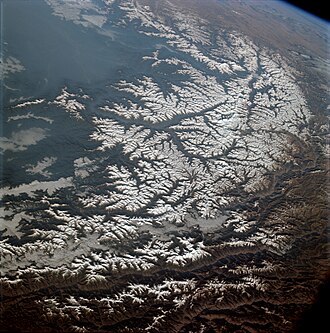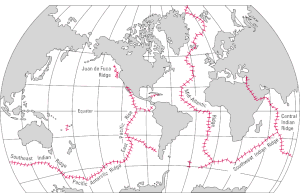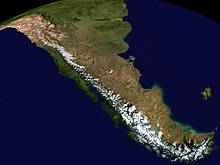Mountain range

Amountain rangeorhill rangeis a series ofmountainsorhillsarranged in a line and connected by high ground. Amountain systemormountain beltis a group of mountain ranges with similarity in form, structure, and alignment that have arisen from the same cause, usually anorogeny.[1]Mountain ranges are formed by a variety of geological processes, but most of the significant ones on Earth are the result ofplate tectonics.[2]Mountain ranges are also found on many planetary mass objects in theSolar Systemand are likely a feature of mostterrestrial planets.
Mountain ranges are usually segmented byhighlandsormountain passesandvalleys.Individual mountains within the same mountain range do not necessarily have the samegeologic structureorpetrology.They may be a mix of different orogenic expressions andterranes,for examplethrust sheets,uplifted blocks,foldmountains, andvolcaniclandforms resulting in a variety ofrock types.
Major ranges
[edit]
Most geologically young mountain ranges on the Earth's land surface are associated with either thePacific Ring of Fireor theAlpide belt.The Pacific Ring of Fire includes theAndesof South America, extends through theNorth American Cordillera,theAleutian Range,on throughKamchatka Peninsula,Japan,Taiwan,thePhilippines,Papua New Guinea,toNew Zealand.[3]The Andes is 7,000 kilometres (4,350 mi) long and is often considered the world's longest mountain system.[4]
The Alpide belt stretches 15,000 km across southernEurasia,fromJavain MaritimeSoutheast Asiato theIberian PeninsulainWestern Europe,including the ranges of theHimalayas,Karakoram,Hindu Kush,Alborz,Caucasus,and theAlps.[5]The Himalayas contain the highest mountains in the world, includingMount Everest,which is 8,848 metres (29,029 ft) high.[6]
Mountain ranges outside these two systems include theArctic Cordillera,Appalachians,Great Dividing Range,East Siberians,Altais,Scandinavians,Qinling,Western Ghats,Vindhyas,Byrrangas,and theAnnamite Range.If the definition of a mountain range is stretched to include underwater mountains, then theOcean Ridgeforms the longest continuous mountain system on Earth, with a length of 65,000 kilometres (40,400 mi).[7]
Climate
[edit]
The position of mountain ranges influences climate, such as rain or snow.[8]When air masses move up and over mountains, the air cools, producingorographicprecipitation (rain or snow). As the air descends on the leeward side, it warms again (following theadiabatic lapse rate) and is drier, having been stripped of much of its moisture. Often, arain shadowwill affect the leeward side of a range.[9]As a consequence, large mountain ranges, such as the Andes, compartmentalize continents into distinctclimate regions.
Erosion
[edit]Mountain ranges are constantly subjected toerosionalforces which work to tear them down.[10]Thebasinsadjacent to an eroding mountain range are then filled with sediments that are buried and turned intosedimentary rock.Erosion is at work while the mountains are being uplifted until the mountains are reduced to low hills and plains.
The earlyCenozoicuplift of theRocky Mountainsof Colorado provides an example. As the uplift was occurring some 10,000 feet (3,000 m) of mostlyMesozoicsedimentarystratawere removed by erosion over the core of the mountain range and spread as sand and clays across theGreat Plainsto the east.[11]This mass of rock was removed as the range was actively undergoing uplift. The removal of such a mass from the core of the range most likely caused further uplift as the region adjustedisostaticallyin response to the removed weight.
Rivers are traditionally believed to be the principal cause of mountain range erosion, by cutting into bedrock and transporting sediment. Computer simulation has shown that as mountain belts change from tectonically active to inactive, the rate of erosion drops because there are fewer abrasive particles in the water and fewer landslides.[12]
Extraterrestrial "Montes"
[edit]
Mountains on other planets andnatural satellitesof the Solar System, including theMoon,are often isolated and formed mainly by processes such as impacts, though there are examples of mountain ranges (or "Montes" ) somewhat similar to those on Earth.Saturn's moonTitan[13]andPluto,[14]in particular, exhibit large mountain ranges in chains composed mainly of ices rather than rock. Examples include theMithrim MontesandDoom Monson Titan, andTenzing MontesandHillary Monteson Pluto. Some terrestrial planets other than Earth also exhibit rocky mountain ranges, such asMaxwell MontesonVenustaller than any on Earth[15]andTartarus MontesonMars.[16]Jupiter's moonIohas mountain ranges formed from tectonic processes including theBoösaule,Dorian, Hi'iaka andEuboea Montes.[17]
See also
[edit]- Cordillera
- Drainage divide
- List of mountain ranges
- Category:Lists of mountain ranges
- List of mountain types
- Lists of mountains
- Massif
- Mountain chain
- Mountain formation
- Ridge– an elongated mountain or hill, or chain of them
References
[edit]- ^"Definition of mountain system".Mindat.org.Hudson Institute of Mineralogy.Retrieved26 August2017.
- ^Hammond, Allen L. (1971-07-09)."Plate Tectonics (II): Mountain Building and Continental Geology".Science.173(3992): 133–134.doi:10.1126/science.173.3992.133.ISSN0036-8075.
- ^Rosenberg, Matt (22 December 2018)."Ring of Fire".ThoughtCo.
- ^Thorpe, Edgar (2012).The Pearson General Knowledge Manual.Pearson Education India. p. A-36.
- ^Chester, Roy (2008).Furnace of Creation, Cradle of Destruction.AMACOM Div American Mgmt Assn. p.77.ISBN9780814409206.
- ^"Nepal and China agree on Mount Everest's height".BBC. 8 April 2010.
- ^"The mid-ocean ridge is the longest mountain range on Earth".US National Oceanic and Atmospheric Service. 11 Jan 2013.
- ^Beniston, Martin (2006-06-01)."Mountain Weather and Climate: A General Overview and a Focus on Climatic Change in the Alps".Hydrobiologia.562(1): 3–16.doi:10.1007/s10750-005-1802-0.ISSN1573-5117.
- ^"Orographic precipitation".Encyclopedia Britannica.Retrieved23 January2020.
- ^Hilton, Robert G.; West, A. Joshua (June 2020)."Mountains, erosion and the carbon cycle".Nature Reviews Earth & Environment.1(6): 284–299.doi:10.1038/s43017-020-0058-6.ISSN2662-138X.
- ^"A Guide to the Geology of Rocky Mountain National Park, Colorado".USGS. Archived fromthe originalon 2012-10-24.
- ^Egholm, David L.; Knudsen, Mads F.; Sandiford, Mike (2013). "Lifespan of mountain ranges scaled by feedbacks between landslide and erosion by rivers".Nature.498(7455): 475–478.Bibcode:2013Natur.498..475E.doi:10.1038/nature12218.PMID23803847.S2CID4304803.
- ^Mitri, Giuseppe; Bland, Michael T.; Showman, Adam P.; Radebaugh, Jani; Stiles, Bryan;Lopes, Rosaly M. C.;Lunine, Jonathan I.; Pappalardo, Robert T. (2010)."Mountains on Titan: Modeling and observations".Journal of Geophysical Research.115(E10): E10002.Bibcode:2010JGRE..11510002M.doi:10.1029/2010JE003592.ISSN0148-0227.S2CID12655950.
- ^Gipson, Lillian (24 July 2015)."New Horizons Discovers Flowing Ices on Pluto".NASA.Archived fromthe originalon 17 March 2016.Retrieved25 July2015.
- ^Keep, Myra; Hansen, Vicki L. (1994). "Structural history of Maxwell Montes, Venus: Implications for Venusian mountain belt formation".Journal of Geophysical Research.99(E12): 26015.Bibcode:1994JGR....9926015K.doi:10.1029/94JE02636.ISSN0148-0227.S2CID53311663.
- ^Plescia, J.B. (2003)."Cerberus Fossae, Elysium, Mars: a source for lava and water".Icarus.164(1): 79–95.Bibcode:2003Icar..164...79P.doi:10.1016/S0019-1035(03)00139-8.ISSN0019-1035.
- ^Jaeger, W. L. (2003)."Orogenic tectonism on Io".Journal of Geophysical Research.108(E8): 12–1–12–18.Bibcode:2003JGRE..108.5093J.doi:10.1029/2002JE001946.ISSN0148-0227.
